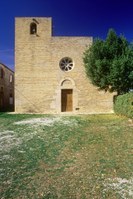Church of St Mary a Vico
The Church of St Mary a Vico near Sant’Omero was built on the remains of a pagan temple dedicated to Hercules. It is thought to be the only Abruzzo’s monument dated before 1000 ad and survived almost intact to these days.
The church’s ground plan is very simple: an extended rectangular base divided into three naves; the central one ending with the apse. On either side, two rows of six pillars mark the passages from one nave to the other. The pillars are without a base and surmounted by stone squared capitals. The five windows obstructed by travertine balustrades can provide very little light internally, although the broad rose window of the main façade makes up for it.
In 1300, the bell tower was added to the main building all together with the ample restoration works of the façade.
The church’s interior presented frescos of exquisite workmanship such as a Madonna and Child Enthroned, where she is caught while tenderly hugging him to her face; then an Annunciation and another Madonna with Child. Unfortunately, the state of the artworks allows us to highlight merely the undeniable Giotto’s strokes (style of painting), almost certainly brought in from Umbria.
Other frescos of mid 14th century found on the inside part of the arch, near the last passage on the left, are by a different artist. Other remains are the half-length Blessing Christ inside a clypeus (shield) and Saint John the Evangelist.
The portal presents stone blocks carved in negative relief that is with the image sunken into the stone instead of standing out. One of them depicts the Agnus Dei, i.e. Lamb of God. Then there are the symbols of the Evangelists: Saint Mark’s winged lion, Saint Lucas winged ox and Saint John’s eagle as well as floral and geometric motives. According to the historians, this decorating style is part of the early Christian revival that followed the Gregorian reform set off in Montecassino’s Abbey.

















